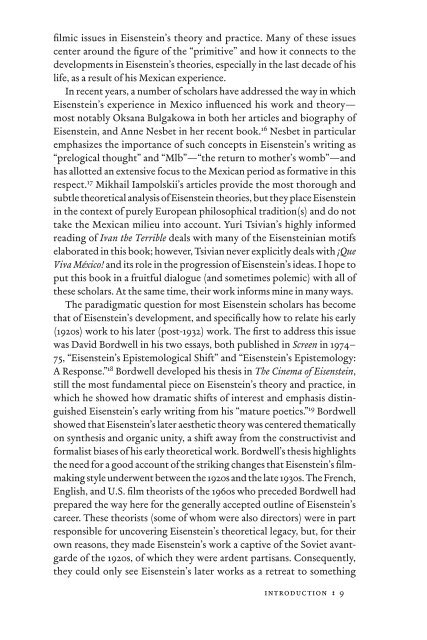In Excess: Sergei Eisentein's Mexico - Cineclub
In Excess: Sergei Eisentein's Mexico - Cineclub
In Excess: Sergei Eisentein's Mexico - Cineclub
Create successful ePaper yourself
Turn your PDF publications into a flip-book with our unique Google optimized e-Paper software.
fi lmic issues in Eisenstein’s theory and practice. Many of these issues<br />
center around the fi gure of the “primitive” and how it connects to the<br />
developments in Eisenstein’s theories, especially in the last decade of his<br />
life, as a result of his Mexican experience.<br />
<strong>In</strong> recent years, a number of scholars have addressed the way in which<br />
Eisenstein’s experience in <strong>Mexico</strong> infl uenced his work and theory—<br />
most notably Oksana Bulgakowa in both her articles and biography of<br />
Eisenstein, and Anne Nesbet in her recent book. 16 Nesbet in particular<br />
emphasizes the importance of such concepts in Eisenstein’s writing as<br />
“prelogical thought” and “Mlb”—“the return to mother’s womb”—and<br />
has allotted an extensive focus to the Mexican period as formative in this<br />
respect. 17 Mikhail Iampolskii’s articles provide the most thorough and<br />
subtle theoretical analysis of Eisenstein theories, but they place Eisenstein<br />
in the context of purely European philosophical tradition(s) and do not<br />
take the Mexican milieu into account. Yuri Tsivian’s highly informed<br />
reading of Ivan the Terrible deals with many of the Eisensteinian motifs<br />
elaborated in this book; however, Tsivian never explicitly deals with ¡Que<br />
Viva México! and its role in the progression of Eisenstein’s ideas. I hope to<br />
put this book in a fruitful dialogue (and sometimes polemic) with all of<br />
these scholars. At the same time, their work informs mine in many ways.<br />
The paradigmatic question for most Eisenstein scholars has become<br />
that of Eisenstein’s development, and specifi cally how to relate his early<br />
(1920s) work to his later (post-1932) work. The fi rst to address this issue<br />
was David Bordwell in his two essays, both published in Screen in 1974–<br />
75, “Eisenstein’s Epistemological Shift” and “Eisenstein’s Epistemology:<br />
A Response.” 18 Bordwell developed his thesis in The Cinema of Eisenstein,<br />
still the most fundamental piece on Eisenstein’s theory and practice, in<br />
which he showed how dramatic shifts of interest and emphasis distinguished<br />
Eisenstein’s early writing from his “mature poetics.” 19 Bordwell<br />
showed that Eisenstein’s later aesthetic theory was centered thematically<br />
on synthesis and organic unity, a shift away from the constructivist and<br />
formalist biases of his early theoretical work. Bordwell’s thesis highlights<br />
the need for a good account of the striking changes that Eisenstein’s fi lmmaking<br />
style underwent between the 1920s and the late 1930s. The French,<br />
English, and U.S. fi lm theorists of the 1960s who preceded Bordwell had<br />
prepared the way here for the generally accepted outline of Eisenstein’s<br />
career. These theorists (some of whom were also directors) were in part<br />
responsible for uncovering Eisenstein’s theoretical legacy, but, for their<br />
own reasons, they made Eisenstein’s work a captive of the Soviet avantgarde<br />
of the 1920s, of which they were ardent partisans. Consequently,<br />
they could only see Eisenstein’s later works as a retreat to something<br />
introduction : 9


